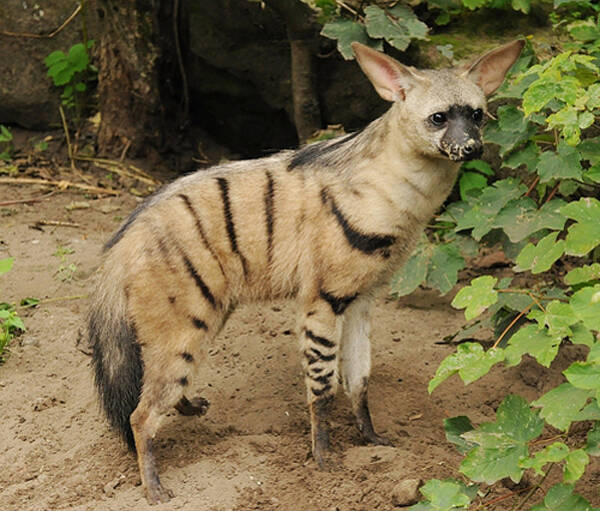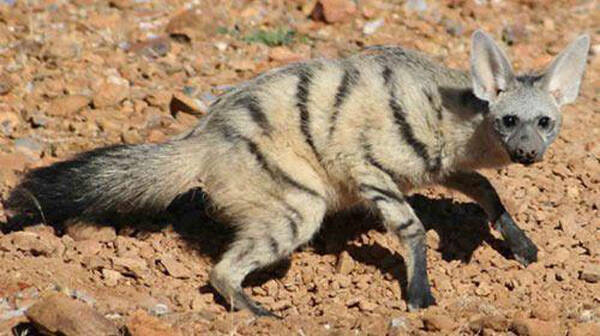Proteles cristatus
IUCN
LCBasic Information
Scientific classification
- name:Proteles cristatus
- Scientific Name:Proteles cristatus,Aardwolf, Hyena
- Outline:Carnivora
- Family:Cynopodidae Hyaenidae Coyote
Vital signs
- length:55-80cm
- Weight:9-14kg
- lifetime:About 12 years
Feature
Timid, when attacked by enemies, it releases a foul fluid from its anus, mainly feeding on termites
Distribution and Habitat
Distributed in the open areas south of the Sahara Desert in Africa, south to the Union of South Africa. Coyotes are distributed in southern Africa, Angola, Botswana, Egypt, Eritrea, Ethiopia, Kenya, Mozambique, Namibia, Somalia, South Africa, South Sudan, Sudan, Swaziland, the United Republic of Tanzania, Uganda, Zambia and Zimbabwe.
Coyotes live in grasslands, wilderness and other areas. They are commonly seen in habitats with open views, such as gravel deserts and semi-desert grasslands with cacti, low shrubs, etc. They hide in burrows during the day. They are active at night.
Appearance
The head and body length of the hyena is 55-80 cm, the shoulder height is 48-80 cm, the tail length is 20-30 cm, and the weight is 9-14 kg. Female individuals are significantly larger than males. The appearance is quite similar to that of hyenas, with high shoulders and low hips; there is a long mane on the dorsal midline from the back of the head to the hips, the color ranges from light yellow to almost red. The whole body is covered with dense brown needle hair, but there are tan stripes on the sides and limbs; the tail is 30 cm long, and the tail hair is long and fluffy. The front legs are longer than the hind legs, and the ears are large and the snout is pointed.
Their bodies are very different from the more well-known spotted hyenas. The appearance of the body is more inclined, but their snouts are more sensitive, which is more suitable for animals like them who feed on insects. Their teeth are more simplified, and they have a long and flexible tongue full of sticky saliva. The
Details
Coyote (scientific name: Proteles cristatus) is also known as Aardwolf in English. It has two subspecies.

The coyote is small, its teeth are highly degenerate, and its body shape is far from the streamline theory; the opening angle of its mouth is almost the smallest among beasts, which greatly limits its bite area and strength; its claws are suitable for digging the soil, but not for fighting and climbing. No matter from which angle, the coyote is far from the opponent of wild cats, cheetahs, and lions. Unlike spotted hyenas, which live in clans, each pair of coyotes live far from each other. They mark their foraging territory by scent marking, bravely attacking intruders, and search for termite mounds on their own, or even live in separate caves. Since they are active only at night, it is extremely difficult to see them.
Coyotes live in burrows (often looking for abandoned caves of aardvarks). They are nocturnal. Coyotes are different from other hyenas in that they do not prey on large animals, but on insects, mainly termites, and also eat insect larvae and carrion. Using its long, sticky tongue, a coyote can catch 300,000 termites every night in the summer. In the winter, termites are much scarcer, reaching only one-fifth of the summer, resulting in severe weight loss. Coyotes do not eat meat, but feed on insects, which makes it easier for coyotes to obtain food than carnivores.
Females enter estrus in late June and often mate within the first two weeks. The gestation period is 90 days, and usually four cubs are born. During this period, the male plays a role in protecting the territory and is responsible for repelling attacks from animals such as jackals. Both males and females feed and care for the cubs together. After 3-4 months, the cubs are weaned and forage in the territory. After about a year, the cubs leave their parents' territory and rarely return. Males reach sexual maturity at 2 years old and females at 3 years old.

When the breeding season arrives, a dominant male coyote has a dual interest in the reproduction process. He mates with his mate for up to four hours to ensure his paternity. He then keeps an eye on his mate to ensure that no other males are secretly having sex with his mate. Once the danger period is over, she becomes a meanie herself, hanging around the lower-ranking males around the territory, looking for a mate who belongs to someone else and is willing to mate with her. In his need for additional sex, the male hyena may be successful, but he will not abandon his original mate for some self-serving reasons. The problem facing the female hyena is that in order to get enough nutrients to ensure the smooth lactation period, she needs to consume nearly 250,000 termites every night, a difficult task that may take her out of the nest for up to 3 hours. When the pups are small and still confined to the burrow, the female can safely leave them to find food, but after a while, when they begin to poke their heads out of the burrow, the situation changes.
During this time, her offspring are more likely to attract predators, and spotted hyenas are ranked as the most dangerous pup killers among all predators. This dangerous situation arises just as the male hyena begins to take an interest in his family. Thus, every evening before the females leave, the male appears in the den and faithfully watches while his pups play with each other. If anything spooks them, he chases the uninvited guest away. Moreover, the male never leaves the den until the female has returned to nurse her prey. The male's vigilance is in his best interest, for a pair of hyenas can manage to raise one or two pups in a year (the average number of pups surviving in the grasslands of South Africa is 1.5), whereas a single mother is unlikely to raise any pups without a male to help her care for them (the average number of pups a single mother can raise in a year is 0.3). By adopting a monogamous relationship and protecting the pups when they are most vulnerable, a male hyena increases his reproductive success fivefold. In other words, he does this with one mate, equal to at least six females raising their own pups. To this end, it takes the best care of these cubs.
Grassland burning and overgrazing are the main reasons for the decline in the total number of coyotes. The coyote's self-defense weapon is its stench. Its thin body has little meat, so lions can kill it but don't eat it. Some people speculate that the coyote's stripes are to mimic the ferocious hyena, so that many carnivores dare not provoke it. The natural enemies of coyotes include humans and domestic dogs, as well as rat snakes and leopards. Many carnivores open their bloody mouths to show their teeth when threatening their enemies, but coyotes close their mouths and do not show their teeth. Instead, they stand up their hair to make their bodies larger. When the enemy attacks, it releases a foul fluid from its anus. Many areas where coyotes live have established well-managed protected areas.
Listed in the 2015 IUCN Red List of Threatened Species ver 3.1 - Low Concern (LC).
Protect wild animals and eliminate game.
Maintaining ecological balance is everyone's responsibility!








